
Chinese Journal of Applied Chemistry ›› 2021, Vol. 38 ›› Issue (10): 1310-1325.DOI: 10.19894/j.issn.1000-0518.210382
• Review • Previous Articles Next Articles
Research Progress of Polymeric Hierarchical Microstructures and Their Properties
Wei HONG, Li-Quan WANG( ), Jia-Ping LIN(
), Jia-Ping LIN( )
)
- School of Materials Science and Engineering,East China University of Science and Technology,Shanghai 200237,China
-
Received:2021-07-30Accepted:2021-09-08Published:2021-10-01Online:2021-10-15 -
Contact:Li-Quan WANG,Jia-Ping LIN -
About author:jlin@ecust.edu.cn; lq_wang@ecust.edu.cn;
-
Supported by:National Natural Science Foundation of China(51833003)
CLC Number:
Cite this article
Wei HONG, Li-Quan WANG, Jia-Ping LIN. Research Progress of Polymeric Hierarchical Microstructures and Their Properties[J]. Chinese Journal of Applied Chemistry, 2021, 38(10): 1310-1325.
share this article
图 Fig. | 研究方法 Method | 分子结构 Molecular structure | 简介 Brief introduction |
|---|---|---|---|
| 1 | 实验合成 Experimental synthesis | P(IS)4IP和PI(SI)2 | 两种分子构型多嵌段共聚物本体在不同嵌段体积分数下的自组装行为 Self?assembly behaviors of multiblock copolymers with two molecular configurations under different volume fractions of blocks |
| 2 | 理论和耗散粒子动力学 Theory and dissipative particle dynamics | C(BA)mBC | 多嵌段共聚物本体自组装行为 Self?assembly behaviors of multiblock copolymers |
| 3 | 自洽场理论 Self?consistent field theory | A(BC)n | 多嵌段共聚物本体在不同的相互作用参数及嵌段体积分数下的自组装行为 Self?assembly behaviors of multiblock copolymer under different interaction parameters and volume fractions of blocks |
| 4 | 耗散粒子动力学 Dissipative particle dynamics | A(BC)3 | 多嵌段共聚物本体在薄膜受限下随着薄膜厚度的变化能自组装形成不同的形貌 Multiblock copolymers can self?assemble into different morphologies with the change of film thickness |
| 5 | 自洽场/密度泛函理论 Self?consistent field/density functional theory | A(BA)5/纳米粒子混合物 A(BA)5/Nanoparticle mixture | 多嵌段共聚物与纳米粒子共混物的自组装行为 Self?assembly behaviors of multiblock copolymer and nanoparticle mixture |
| 6 | 自洽场理论 Self?consistent field theory | 线性-梳状嵌段共聚物Comb?coil block copolymer | 线性-梳状嵌段共聚物本体的自组装行为 Self?assembly behaviors of comb?coil block copolymers |
| 7 | 自洽场/密度泛函理论 Self?consistent field/density functional theory | 聚合物接枝纳米粒子 Polymer tethered nanoparticles | 线性嵌段共聚物与纳米粒子共价连接的体系自组装行为 Self?assembly behaviors of linear block copolymer tethered nanoparticles |
| 8 | 自洽场理论 Self?consistent field theory | Cx(RC)nRy刚柔共聚物 Cx(RC)nRy Rod?coil copolymer | 刚柔多嵌段共聚物本体能自组装形成多级液晶微相结构 Rod?coil multiblock copolymers can self?assemble into hierarchical smectic structures |
Table 1 Brief introduction to self?assembly behaviors of several polymer systems
图 Fig. | 研究方法 Method | 分子结构 Molecular structure | 简介 Brief introduction |
|---|---|---|---|
| 1 | 实验合成 Experimental synthesis | P(IS)4IP和PI(SI)2 | 两种分子构型多嵌段共聚物本体在不同嵌段体积分数下的自组装行为 Self?assembly behaviors of multiblock copolymers with two molecular configurations under different volume fractions of blocks |
| 2 | 理论和耗散粒子动力学 Theory and dissipative particle dynamics | C(BA)mBC | 多嵌段共聚物本体自组装行为 Self?assembly behaviors of multiblock copolymers |
| 3 | 自洽场理论 Self?consistent field theory | A(BC)n | 多嵌段共聚物本体在不同的相互作用参数及嵌段体积分数下的自组装行为 Self?assembly behaviors of multiblock copolymer under different interaction parameters and volume fractions of blocks |
| 4 | 耗散粒子动力学 Dissipative particle dynamics | A(BC)3 | 多嵌段共聚物本体在薄膜受限下随着薄膜厚度的变化能自组装形成不同的形貌 Multiblock copolymers can self?assemble into different morphologies with the change of film thickness |
| 5 | 自洽场/密度泛函理论 Self?consistent field/density functional theory | A(BA)5/纳米粒子混合物 A(BA)5/Nanoparticle mixture | 多嵌段共聚物与纳米粒子共混物的自组装行为 Self?assembly behaviors of multiblock copolymer and nanoparticle mixture |
| 6 | 自洽场理论 Self?consistent field theory | 线性-梳状嵌段共聚物Comb?coil block copolymer | 线性-梳状嵌段共聚物本体的自组装行为 Self?assembly behaviors of comb?coil block copolymers |
| 7 | 自洽场/密度泛函理论 Self?consistent field/density functional theory | 聚合物接枝纳米粒子 Polymer tethered nanoparticles | 线性嵌段共聚物与纳米粒子共价连接的体系自组装行为 Self?assembly behaviors of linear block copolymer tethered nanoparticles |
| 8 | 自洽场理论 Self?consistent field theory | Cx(RC)nRy刚柔共聚物 Cx(RC)nRy Rod?coil copolymer | 刚柔多嵌段共聚物本体能自组装形成多级液晶微相结构 Rod?coil multiblock copolymers can self?assemble into hierarchical smectic structures |
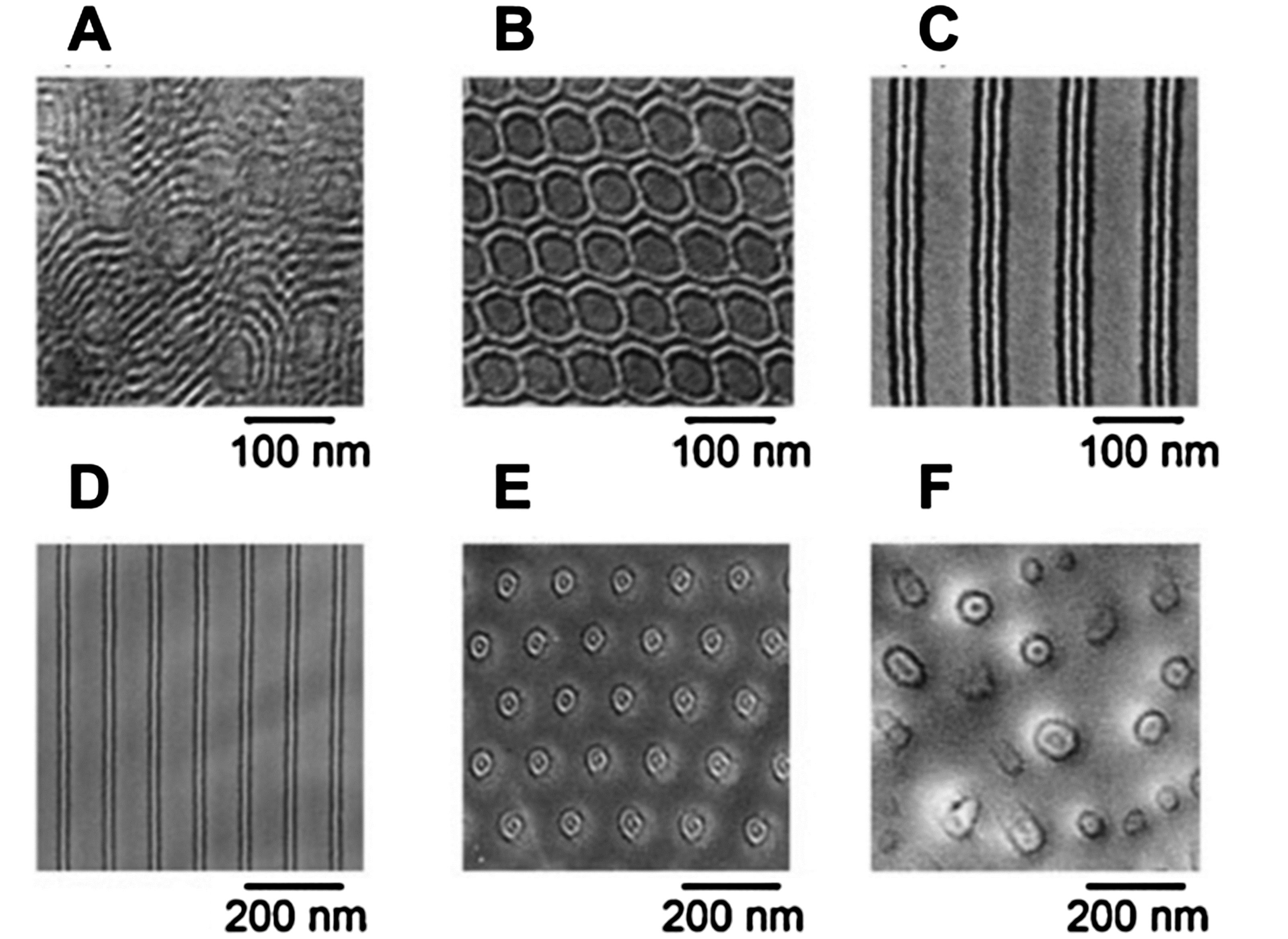
Fig.1 Various morphologies of undecablock terpolymers of the P(IS)4IP type (A,B,C) and hexablock terpolymers of the P(IS)2I type (D,E, F). Volume percentages of P component are (A) 8%, (B) 21%, (C) 53%, (D) 64%, (E) 75% and (F) 88%, respectively. The end poly(2-vinylpyridine) (P) are incompatible with both the polyisoprene (I) and polystyrene (S)[25]
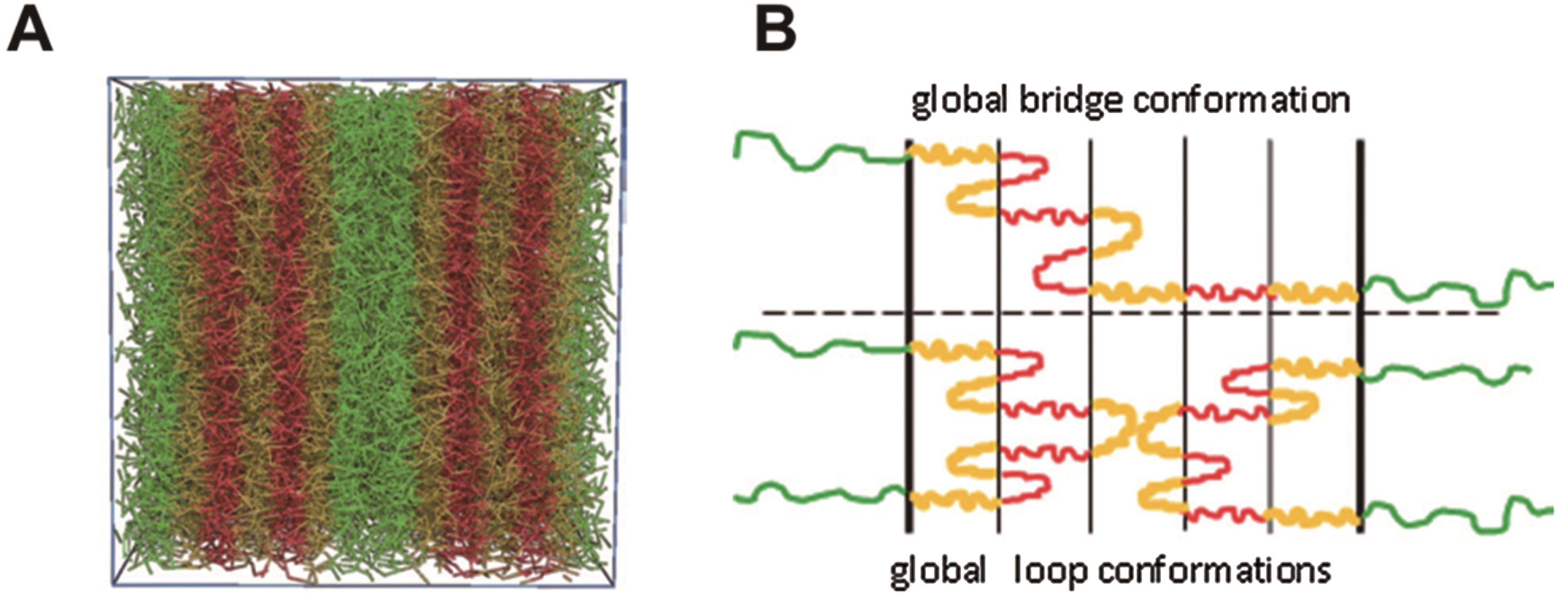
Fig.2 (A) Morphology formed by C3-(B2A2)3B2-C3 with aAB=75 and aBC=120 (aAB represents the interaction parameter bewteen A and B used in DPD sumulations). A-, B-, and C-blocks are denoted by red, yellow, and green, respectively. (B) A schematic representation of a global bridge (top) and a global loop (bottom) conformation for a C-b-(B-b-A)4-B-b-C multiblock copolymer[26]

Fig.3 Hierarchical microstructures self-assembled from A(BC)3 multiblock copolymer with (A) χABN = 200, χACN = 250, and χBCN = 500, (B) χABN = 100, χACN = 50, and χBCN = 600, and (C) χABN = 150, χACN = 100, and χBCN = 600. In (A), sphere-in-lamellae, cylinders-in-lamellae, lamellae-in-lamella, cylinders-in-cylinder, and spheres-in-sphere are observed in turn with increasing the volume fractions of A blocks, and the two length-scale-order structures are in parallel. In (B) and (C), cylinders-in-lamellae, lamellae-in-lamella, lamellae-in-cylinder, and lamellae-in-sphere are observed with increasing the volume fractions of A blocks, and the two length-scale-order structures are in perpendicular. The blue, red, and green colors are assigned to A, B, and C blocks, respectively[28]
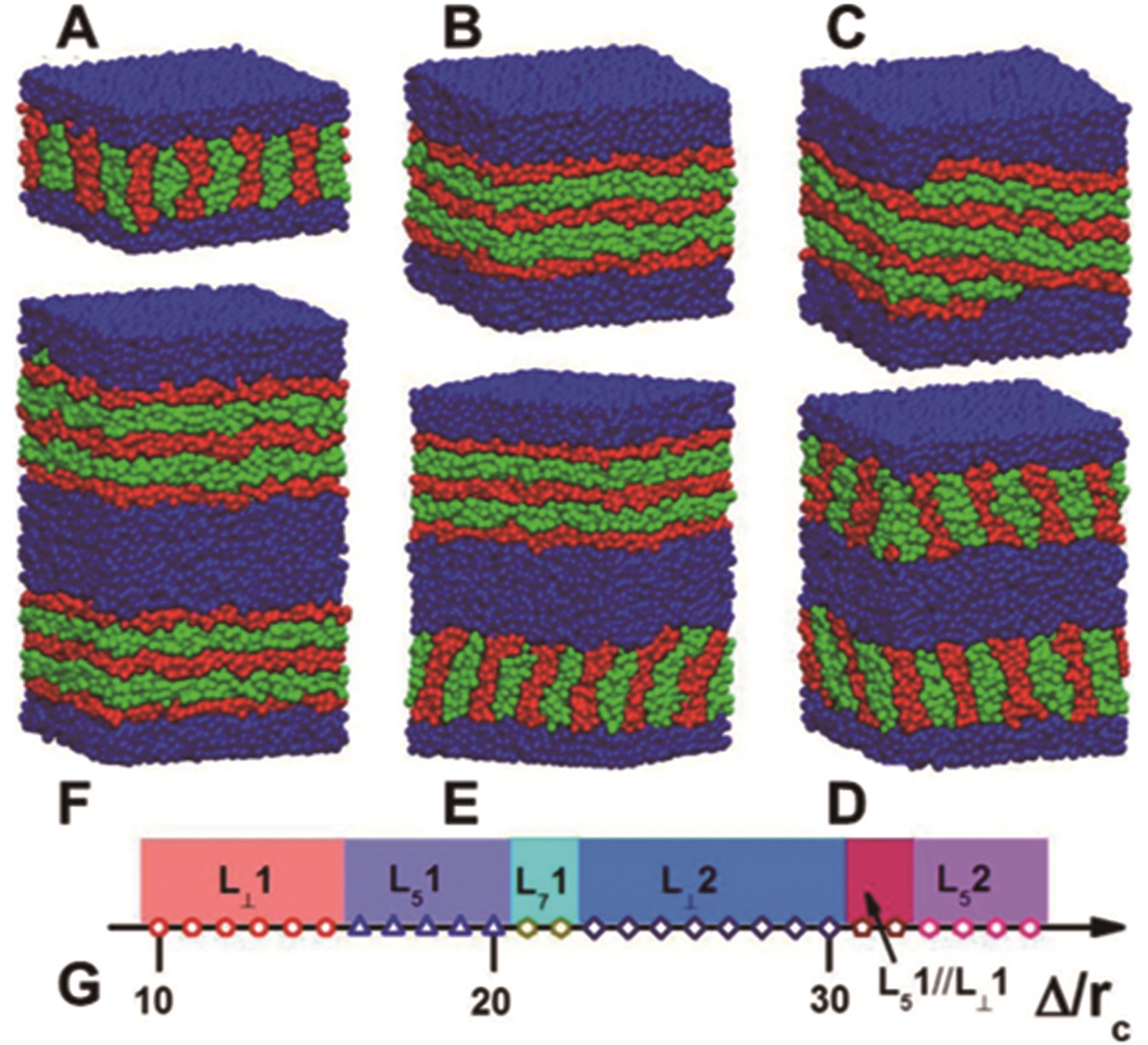
Fig.4 Hierarchical microstructures self-assembled from A(BC)3 multiblock copolymer thin films: (A) L⊥1, (B) L51, (C) L71, (D) L⊥2, (E) L51//L⊥1, and (F) L52. (G) One-dimensional diagram for hierarchical microstructures as a function of Δ/rc. The interaction parameters are aAB = 160, aAC = 80, aBC = 400. In the representations such as L31, the first bold letter L, subscripts, and last number denote lamellae, the number of the parallel packed small-length-scale lamellae (the symbol ⊥ means that the small-length-scale lamellae are perpendicular to the large-length-scale lamellae), and the number of the large-length-scale structures, respectively[29]
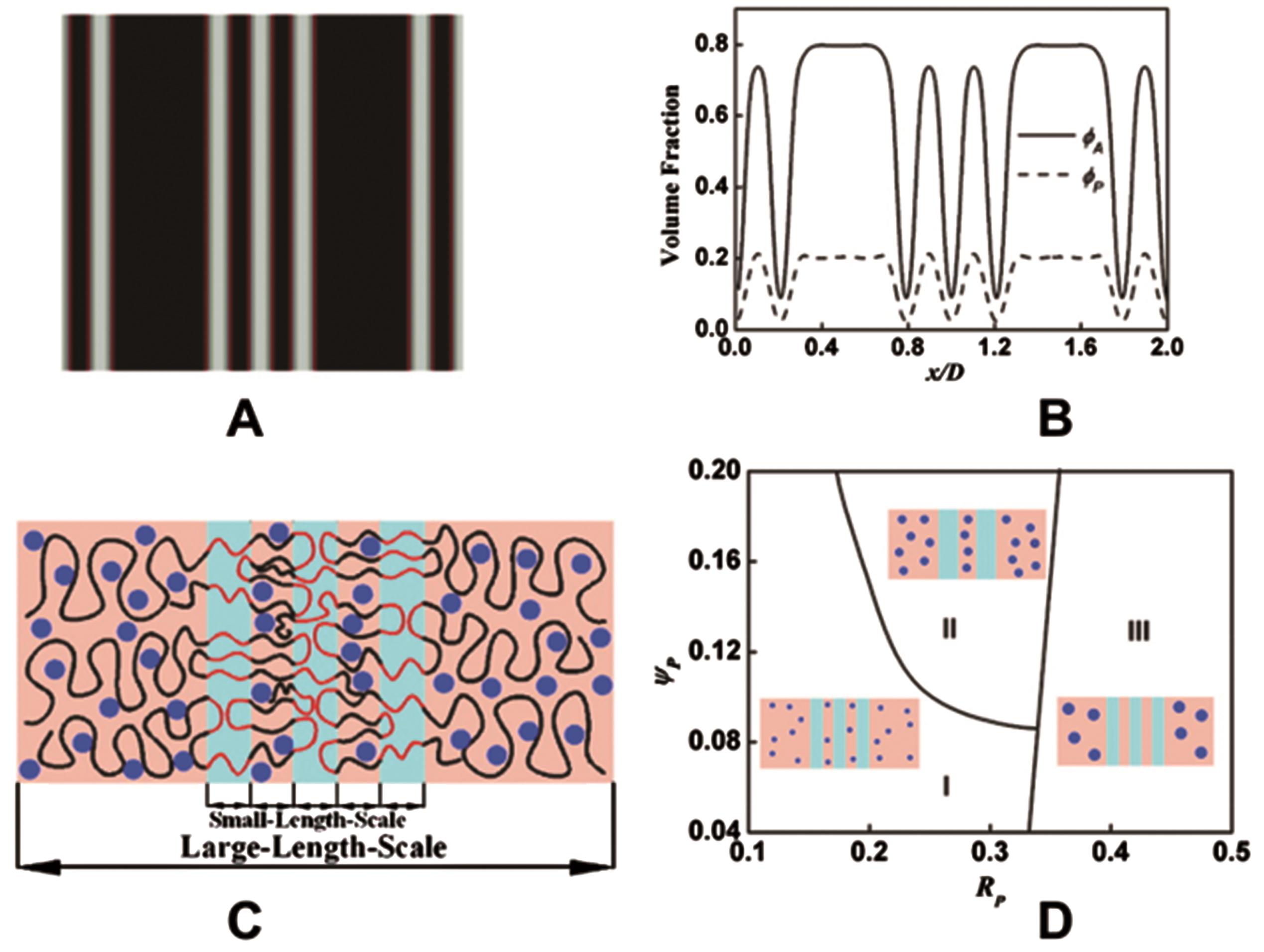
Fig.5 (A) Two-dimensional density profile of nanoparticles for linear-alternating copolymer/nanoparticle system. Light gray regions represent lower local volume fraction of particles, while black regions represent higher local volume fraction of particles. (B) Distribution profiles of A-type segments and nanoparticles along the line normal to lamella. (C) Schematic representation of the nanoparticle arrangement in the lamellar-within-lamellar structure formed by the linear-alternating copolymers. (D) Nanoparticle distribution in the lamellar-within-lamellar structure for a range of nanoparticle radii RP and nanoparticle concentrations ΨP[32]

Fig.6 (A) Schematic presentation of the comb-coil block copolymer. (B) Two-dimensional density plots of (1) coil blocks, (2) A blocks of comb blocks, and (3) branches for various structures: (a) parallel lamella-within-lamella, (b) perpendicular lamella-within-lamella, (c) cylinder-within-lamella, (d) lamella-within-cylinder, and (e) cylinder-within-cylinder. Dark- and light-gray regions indicate high and low local volume fractions of a species, respectively. Image 4 shows corresponding schematic illustrations, where the light-blue, white, and light-red regions represent coil block domains, domains rich in A blocks of the comb block, and branch domain, respectively. The blue and red lines denote the A and B blocks, respectively[35]
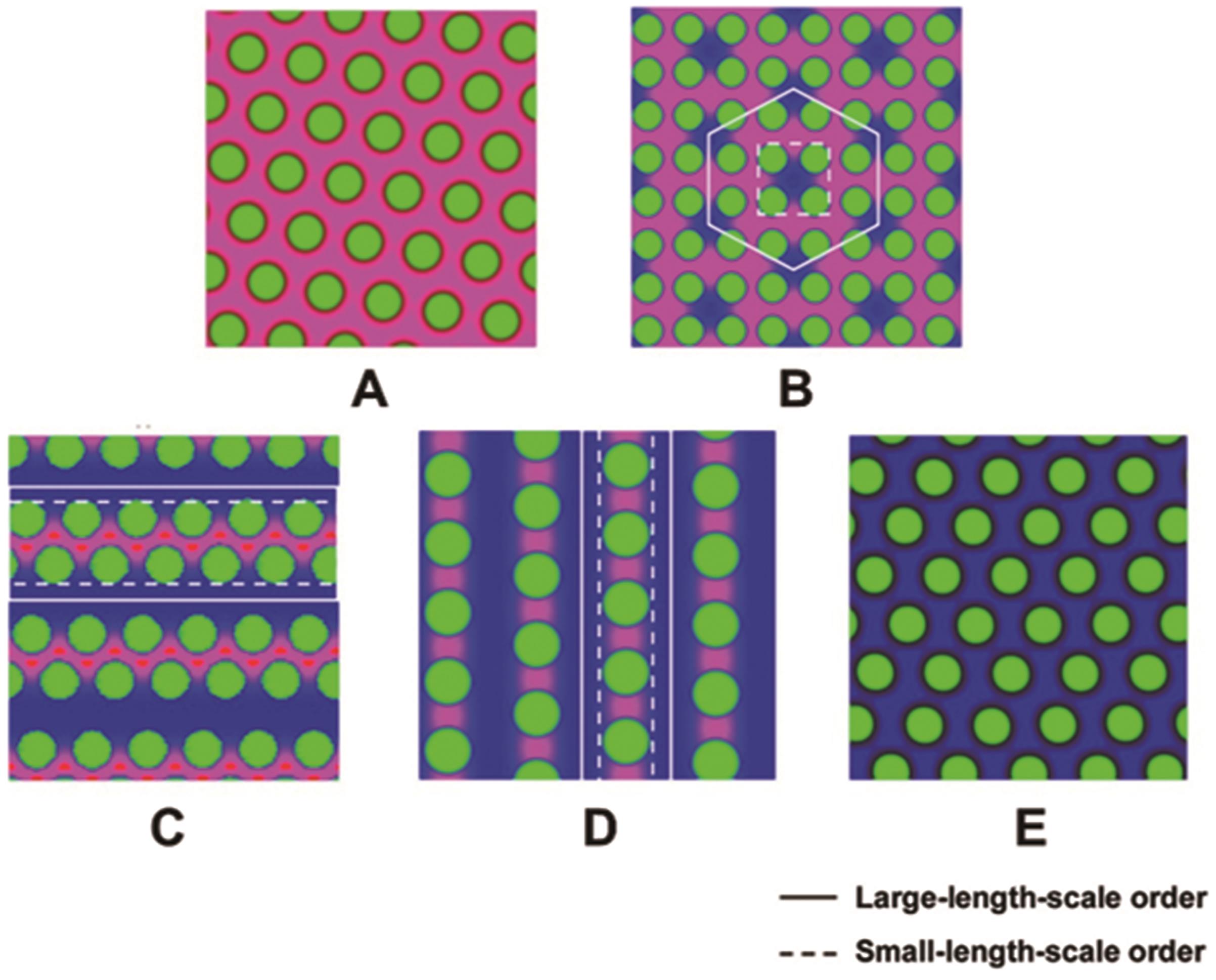
Fig.7 Ordered nanostructures self-assembled from ABP macromolecules with various A block volume fractions: (A) cylinders whose minority domains are occupied by nanoparticles (CP), fA = 0.2; (B) cylinders with nanoparticle cylinders at the interfaces (CP-in-C), fA = 0.4; (C) lamellae with nanoparticle cylinders at the interfaces (CP-in-LⅠ), fA = 0.6; (D) lamellae with nanoparticle cylinders inside the domain (CP-in-LⅡ), fA = 0.8; (E) cylinders (CP), fA = 0.9. The parameters are RP/Rg = 0.4 and the Flory-Huggins interaction parameters χABN = χAPN = χBPN = 30.0. The blue, red and green colors are assigned to A blocks, B blocks, and P particles, respectively[37]
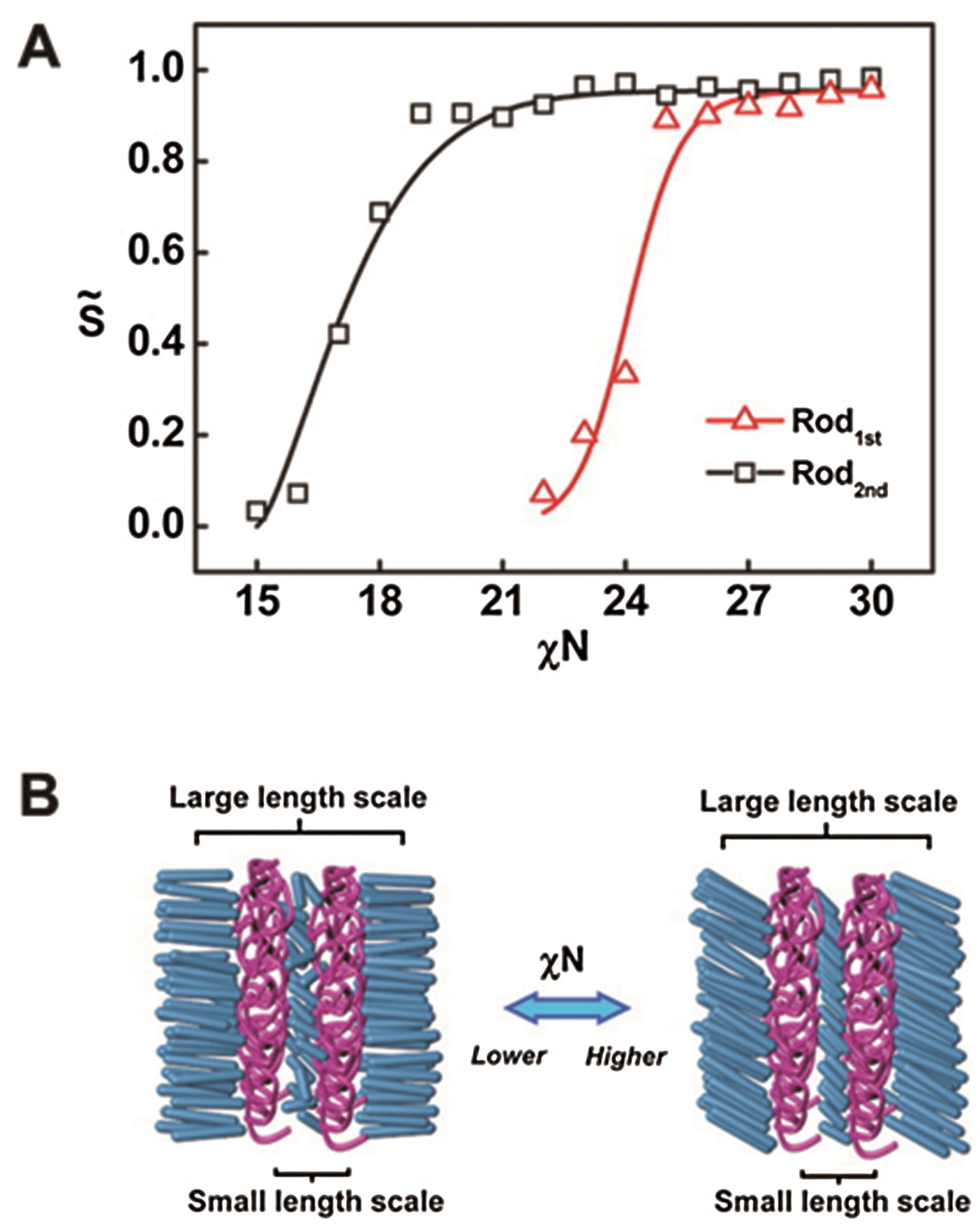
Fig.8 (A) Order parameter S? of short rod (Rodfirst) and long end rod (Rodsecond) as a function of interaction strength for χN for hierarchical smectic phases. (B) Schematic illustration of the phase transition between Iso-in-SA and SC-in-SC with the variation of order parameter S?. The volume fractions of each block are fC? = ΔfC = 0.15, ΔfR = 0.21, and fR? = 0.49. Iso-in-SA represents that a hierarchical smectic microstructure including isotropic phases (small-length-scale) and SA (large-length-scale)[24]

Fig.9 One-dimensional density profiles of A, B, and C blocks of A(BC)2 multiblock copolymers with fA = 0.5 along the z-direction at various χN: (A) χN = 48, (B) χN = 64, and (C) χN = 80. The top images show the corresponding two-dimensional structures. Dimensionless (D) extensional moduli (K33), (E) shear moduli (K44), and (F) Young’s moduli (E) as a function of χN for A(BC)2 multiblock copolymers and AB diblock copolymers, respectively. The interaction strength χN in diblock and multiblock copolymers are the same[43]

Fig.10 Vertically modulus-shifted master curves for the storage (G ?) and loss moduli (G") as a function of shear frequency for various structures with various directions of shear: (A) parallel, (B) vertical, and (C) transverse. In (B) and (C), the shift factors appear as same as those in (A). Insets at the bottom of (A), (B), and (C) are schematic illustrations of three shearing ways, where the solid arrow represents shear direction, and the dashed arrow denotes the velocity gradient[44]
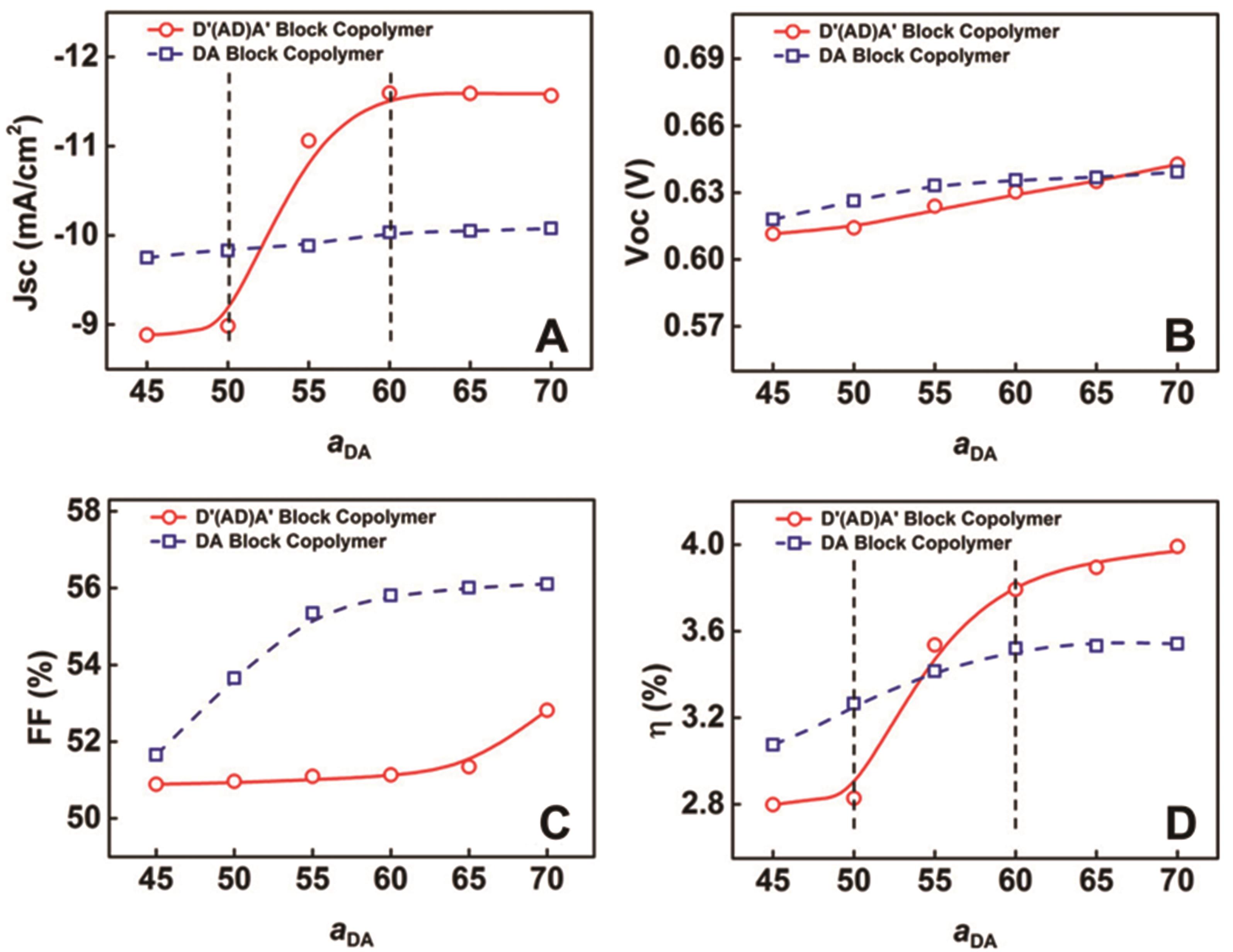
Fig.11 Plots of (A) short-current density (Jsc), (B) open-circuit voltages (Voc), (C) fill factor (FF), and (D) power conversion efficiencies (η) as a function of repulsive interaction parameter aDA for D?(AD)A? multiblock copolymers and DA diblock. The ration of donors D to acceptors A is 1∶1. The adopted block length of the diblock copolymer is the same as that of the long block of the multiblock copolymer[23]
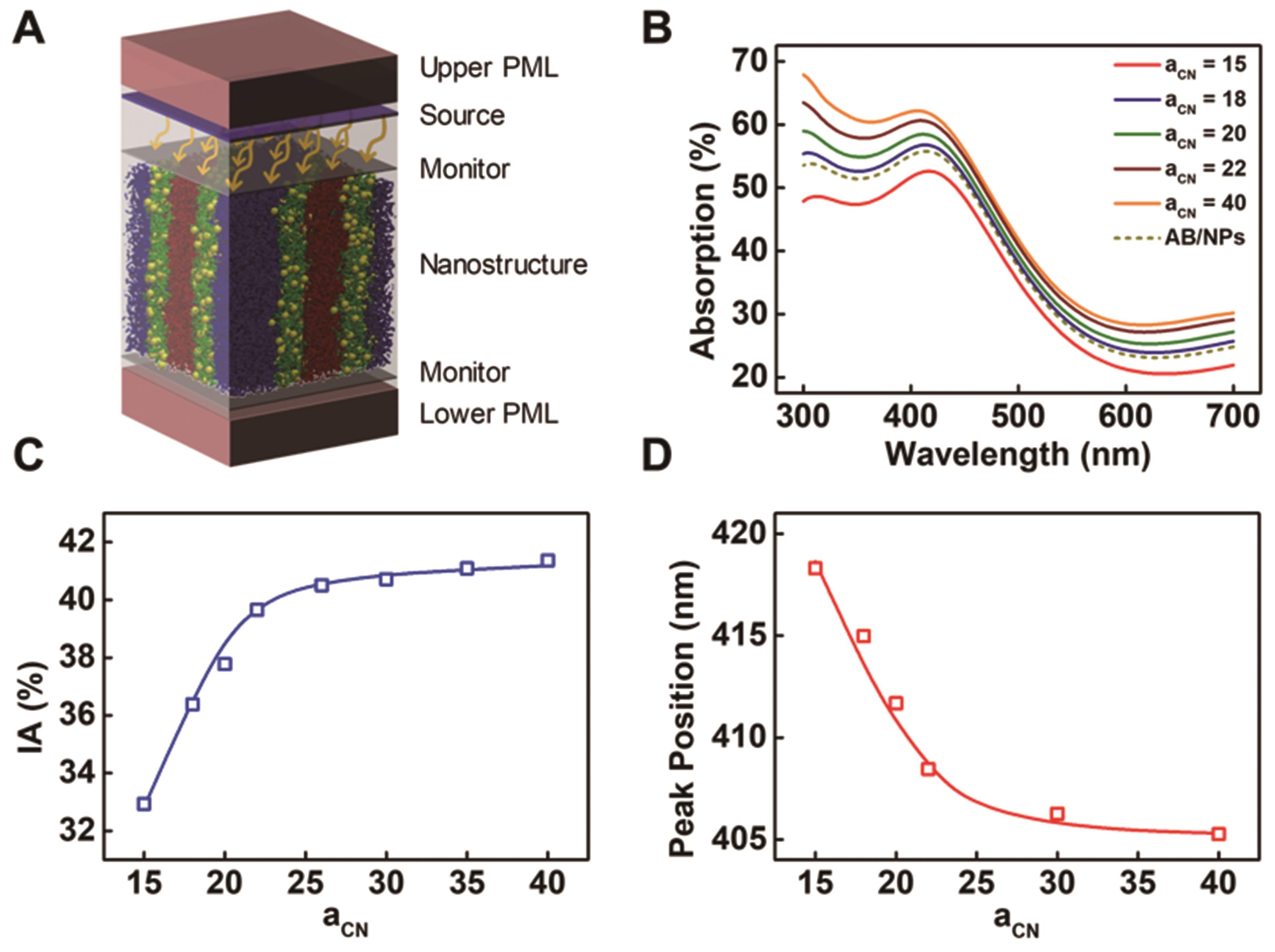
Fig.12 (A) Schematic illustration of the computational domain used in the FDTD simulations. (B) The solid lines are the optical absorption spectra of A(BC)1/NP mixtures at various aCN. The dashed line is the optical absorption spectrum of the AB/NP mixture with a general lamellar structure. (C) Plot of the integrated absorption (IA) of A(BC)1/NP mixtures as a function of the repulsive parameter aCN. (D) Plot of the wavelength of absorption peak of A(BC)1/NP mixtures as a function of aCN[46]
| 1 | BAER E, HILTNER A, KEITH H. Hierarchical structure in polymeric materials[J]. Science, 1987, 235(4792): 1015-1022. |
| 2 | LAKES R. Materials with structural hierarchy[J]. Nature, 1993, 361(6412): 511-515. |
| 3 | JÄGER I, FRATZL P. Mineralized collagen fibrils: a mechanical model with a staggered arrangement of mineral particles[J]. Biophys J, 2000, 79(4): 1737-1746. |
| 4 | AUTUMN K, LIANG Y A, HSIEH S T, et al. Adhesive force of a single gecko foot-hair[J]. Nature, 2000, 405(6787): 681-685. |
| 5 | FRATZL P, GUPTA H, PASCHALIS E, et al. Structure and mechanical quality of the collagen-mineral nano-composite in bone[J]. J Mater Chem, 2004, 14(14): 2115-2123. |
| 6 | BUTT H, YETISEN A K, MISTRY D, et al. Morpho butterfly-inspired nanostructures[J]. Adv Opt Mater, 2016, 4(4): 497-504. |
| 7 | 张鸿昊, 林乃波, 刘向阳. 蚕丝和蜘蛛丝纤维多级结构对力学性能的影响[J]. 功能高分子学报, 2018, 31(6): 501-512. |
| ZHANG H H, LIN N B, LIU X Y. Effects of multi-level structure of silk and spider silk on mechanical properties[J]. J Funct Polym, 2018, 31(6): 501-512. | |
| 8 | SANCHEZ C, ARRIBART H, GUILLE M M G. Biomimetism and bioinspiration as tools for the design of innovative materials and systems[J]. Nat Mater, 2005, 4(4): 277-288. |
| 9 | 张彬, 张一波, 杨向光. 多级结构还原氧化石墨烯包覆的钴铁氧体的合成及电化学性能[J]. 应用化学, 2014, 31(12): 1447-1452. |
| ZHANG B, ZHANG Y B, YANG X G. Synthesis and electrochemical performance of reduced graphene oxide coated cobalt iron oxide with hierarchical structure[J]. Chinese J Appl Chem, 2014, 31(12): 1447-1452. | |
| 10 | 隋丽丽, 姜惠烨, 王荻, 等. 多级结构NiO微球的构筑及对刚果红染料的吸附性能[J]. 应用化学, 2021, 38(4): 447-456. |
| SUI L L, JIANG H Y, WANG D, et al. Construction of hierarchical NiO microspheres and the adsorption capacity to congo red azo-dye[J]. Chinese J Appl Chem, 2021, 38(4): 447-456. | |
| 11 | 林进义, 白鲁冰, 安翔, 等. 光电高分子多级结构[J]. 高分子通报, 2019(10): 64-73. |
| LIN J Y, BAI L B, AN X, et al. Herarchical structure of optoelectronic polymer[J]. Polym Bull, 2019(10): 64-73. | |
| 12 | QIN Z, KREPLAK L, BUEHLER M J. Hierarchical structure controls nanomechanical properties of vimentin intermediate filaments[J]. PLoS One, 2009, 4(10): e7294. |
| 13 | 崔旭远, 高万贤. 仿生超疏水材料的研究现状及发展前景[J]. 针织工业, 2018(1): 63-67. |
| CUI X Y, GAO W X. Research situation and development prospect of bionic super-hydrophobic materials[J]. Knit Ind, 2018(1): 63-67. | |
| 14 | ZUO F, ALFONZO C G, BATES F S. Structure and mechanical behavior of elastomeric multiblock terpolymers containing glassy, rubbery, and semicrystalline blocks[J]. Macromolecules, 2011, 44(20): 8143-8153. |
| 15 | SCHEIRS J, PRIDDY D. Modern styrenic polymers: polystyrenes and styrenic copolymers[M]. John Wiley Sons, 2003. |
| 16 | WANG L, LIN J, ZHANG X. Hierarchical microstructures self-assembled from polymer systems[J]. Polymer, 2013, 54(14): 3427-3442. |
| 17 | XU Z, LIN J, ZHANG Q, et al. Theoretical simulations of nanostructures self-assembled from copolymer systems[J]. Polym Chem, 2016, 7(23): 3783-3811. |
| 18 | ALFONZO C G, FLEURY G, CHAFFIN K A, et al. Synthesis and characterization of elastomeric heptablock terpolymers structured by crystallization[J]. Macromolecules, 2010, 43(12): 5295-5305. |
| 19 | PHATAK A, LIM L S, REAVES C K, et al. Toughness of glassy-semicrystalline multiblock copolymers[J]. Macromolecules, 2006, 39(18): 6221-6228. |
| 20 | FLEURY G, BATES F S. Structure and properties of hexa- and undecablock terpolymers with hierarchical molecular architectures[J]. Macromolecules, 2009, 42(10): 3598-3610. |
| 21 | MANSOUR A S, LODGE T P, BATES F S. Mechanical properties of glass continuous poly(cyclohexylethylene) block copolymers[J]. J Polym Sci Part B: Polym Phys, 2012, 50(10): 706-717. |
| 22 | CHEN W, XU T, HE F, et al. Hierarchical nanomorphologies promote exciton dissociation in polymer/fullerene bulk heterojunction solar cells[J]. Nano Lett, 2011, 11(9): 3707-3713. |
| 23 | XU Z, LIN J, ZHANG L, et al. Distinct photovoltaic performance of hierarchical nanostructures self-assembled from multiblock copolymers[J]. ACS Appl Mater Interfaces, 2018, 10(26): 22552-22561. |
| 24 | ZHU X, WANG L, LIN J. Self-assembly of rod-coil multiblock copolymers: a strategy for creating hierarchical smectic structures[J]. J Phys Chem B, 2013, 117(18): 5748-5756. |
| 25 | MATSUSHITA Y. Precise molecular design of complex polymers and morphology control of their hierarchical multiphase structures[J]. Polym J, 2008, 40(3): 177-183. |
| 26 | KLYMKO T, MARKOV V, SUBBOTIN A, et al. Lamellar-in-lamellar self-assembled C-b-(B-b-A)m-b-B-b-C multiblock copolymers: alexander-de Gennes approach and dissipative particle dynamics simulations[J]. Soft Matter, 2009, 5(1): 98-103. |
| 27 | FLEURY G, BATES F S. Perpendicular lamellae in parallel lamellae in a hierarchical CECEC-P hexablock terpolymer[J]. Macromolecules, 2009, 42(5): 1691-1694. |
| 28 | WANG L, LIN J, ZHANG L. Hierarchically ordered microstructures self-assembled from A(BC)n multiblock copolymers[J]. Macromolecules, 2010, 43(3): 1602-1609. |
| 29 | ZHANG X, WANG L, ZHANG L, et al. Controllable hierarchical microstructures self-assembled from multiblock copolymers confined in thin films[J]. Langmuir, 2015, 31(8): 2533-2544. |
| 30 | HUANG E, RUSSELL T, HARRISON C, et al. Using surface active random copolymers to control the domain orientation in diblock copolymer thin films[J]. Macromolecules, 1998, 31(22): 7641-7650. |
| 31 | RUSSELL T, MENELLE A, ANASTASIADIS S, et al. Unconventional morphologies of symmetric, diblock copolymers due to film thickness constraints[J]. Macromolecules, 1991, 24(23): 6263-6269. |
| 32 | ZHANG L, LIN J. Hierarchically ordered nanocomposites self-assembled from linear-alternating block copolymer/nanoparticle mixture[J]. Macromolecules, 2009, 42(4): 1410-1414. |
| 33 | LIN Y, BÖKER A, HE J, et al. Self-directed self-assembly of nanoparticle/copolymer mixtures[J]. Nature, 2005, 434(7029): 55-59. |
| 34 | THOMPSON R B, GINZBURG V V, MATSEN M W, et al. Predicting the mesophases of copolymer-nanoparticle composites[J]. Science, 2001, 292(5526): 2469-2472. |
| 35 | WANG L, LIN J, ZHANG L. Hierarchically ordered microstructures self-assembled from comb-coil block copolymers[J]. Langmuir, 2009, 25(8): 4735-4742. |
| 36 | VAN ZOELEN W, ALBERDA VAN EKENSTEIN G, IKKALA O, et al. Incorporation of PPE in lamellar self-assembled PS-b-P4VP(PDP) supramolecules and PS-b-P4VP diblock copolymers[J]. Macromolecules, 2006, 39(19): 6574-6579. |
| 37 | ZHU X, WANG L, LIN J, et al. Ordered nanostructures self-assembled from block copolymer tethered nanoparticles[J]. ACS Nano, 2010, 4(9): 4979-4988. |
| 38 | YOCKELL-LELIÈVRE H, DESBIENS J, RITCEY A M. Two-dimensional self-organization of polystyrene-capped gold nanoparticles[J]. Langmuir, 2007, 23(5): 2843-2850. |
| 39 | HAATAJA J S, HOUBENOV N, IATROU H, et al. Double smectic self-assembly in block copolypeptide complexes[J]. Biomacromolecules, 2012, 13(11): 3572-3580. |
| 40 | MAEDA R, HAYAKAWA T, TOKITA M, et al. Double liquid crystalline side-chain type block copolymers for hierarchically ordered nanostructures: synthesis and morphologies in the bulk and thin film[J]. React Funct Polym, 2009, 69(7): 519-529. |
| 41 | XIE H L, JIE C K, YU Z Q, et al. Hierarchical supramolecular ordering with biaxial orientation of a combined main-chain/side-chain liquid-crystalline polymer obtained from radical polymerization of 2-vinylterephthalate[J]. J Am Chem Soc, 2010, 132(23): 8071-8080. |
| 42 | WANG K, CHEN F, LI Z, et al. Control of the hierarchical structure of polymer articles via “structuring” processing[J]. Prog Polym Sci, 2014, 39(5): 891-920 |
| 43 | ZHU X, WANG L, LIN J. Distinct elastic response to hierarchical nanostructures[J]. Macromolecules, 2011, 44(20): 8314-8323. |
| 44 | HONG W, LIN J, TIAN X, et al. Distinct viscoelasticity of hierarchical nanostructures self-assembled from multiblock copolymers[J]. Macromolecules, 2020, 53(24): 10955-10963. |
| 45 | RIISE B L, FREDRICKSON G H, LARSON R G, et al. Rheology and shear-induced alignment of lamellar diblock and triblock copolymers[J]. Macromolecules, 1995, 28(23): 7653-7659. |
| 46 | YAN H, COLLINS B A, GANN E, et al. Correlating the efficiency and nanomorphology of polymer blend solar cells utilizing resonant soft X-ray scattering[J]. ACS Nano, 2012, 6(1): 677-688. |
| 47 | LIU Z, XU Z, WANG L, et al. Distinctive optical properties of hierarchically ordered nanostructures self-assembled from multiblock copolymer/nanoparticle mixtures[J]. Macromol Rapid Commun, 2020, 41(12): e2000131. |
| 48 | BOCKSTALLER M R, THOMAS E L. Proximity effects in self-organized binary particle-block copolymer blends[J]. Phys Rev Lett, 2004, 93(16): 166106. |
| 49 | YEN W C, LEE Y H, LIN J F, et al. Effect of TiO2 nanoparticles on self-assembly behaviors and optical and photovoltaic properties of the P3HT-b-P2VP block copolymer[J]. Langmuir, 2011, 27(1): 109-115. |
| 50 | LI F, SHI Y, YUAN K, et al. Fine dispersion and self-assembly of ZnO nanoparticles driven by P3HT-b-PEO diblocks for improvement of hybrid solar cells performance[J]. New J Chem, 2013, 37(1): 195-203. |
| [1] | Bing-Shuai CHEN, Hai-Tao ZHUO, Shu HUANG, Shao-Jun CHEN. Advances of High-Performance Polymer Binders for Silicon-Based Anodes [J]. Chinese Journal of Applied Chemistry, 2023, 40(5): 625-639. |
| [2] | Xue-Bo LEI, Hui-Jing LIU, He-Yu DING, Guo-Dong SHEN, Run-Jun SUN. Research Progress on Photocatalysts for Degradation of Organic Pollutants in Printing and Dyeing Wastewater [J]. Chinese Journal of Applied Chemistry, 2023, 40(5): 681-696. |
| [3] | Yu-Chen TAO, Xiao-Hui HOU, Deng-Ke YIN, Ye YANG. Effect of Electric Field-Regulating Cholesterol-based Liquid Crystal Films on the Growth and Differentiation of Fibroblasts [J]. Chinese Journal of Applied Chemistry, 2023, 40(4): 546-553. |
| [4] | Jin-Jian LIU, Yi-Wei LU. Multiple-Responsive Coordination Polymers Based on a Carboxybenzyl Viologen Ligand [J]. Chinese Journal of Applied Chemistry, 2023, 40(3): 397-403. |
| [5] | Bo XIONG, Tai-Hua LI, Wu-Ping ZHOU, Chang-Yu LIU, Xiao-Long XU. Preparation of Cu2O/CuO-g-C3N4 Adsorbent by One-step Thermal Polymerization and Adsorption Properties for Methyl Orange [J]. Chinese Journal of Applied Chemistry, 2023, 40(3): 420-429. |
| [6] | Jin-Jian LIU, Na LIU, Feng-Yi YANG. Synthesis and Photochromic Properties of Two Isostructural Viologen Coordination Polymers [J]. Chinese Journal of Applied Chemistry, 2023, 40(2): 245-251. |
| [7] | Shi-Peng JIANG, Yu-Xi ZHOU, Pei-Ran MENG, Yan-Xuan XIE, Zhi-Yi SONG, Huan-Ying ZHAO, Yue SUN. Preparation and Properties of Ultramicro Imprinting Sensor for Human Serum Albumin via Metal-free Visible-light-induced Atom Transfer Radical Polymerization [J]. Chinese Journal of Applied Chemistry, 2023, 40(2): 299-308. |
| [8] | Yu-Huang LI, Ze-Yi LU, Hong-Mei YUAN, Gang WANG, Cheng-Jiang ZHANG. Preparation and Application of Acylhydrazone Bonded Polymer Gel in Nitrofuran Drugs Analysis [J]. Chinese Journal of Applied Chemistry, 2023, 40(1): 100-108. |
| [9] | Guan-Yu XIE, Mao LI. Topological Metallopolymers Synthesized by Electropolymerization and Their Photoelectric Properties [J]. Chinese Journal of Applied Chemistry, 2022, 39(8): 1246-1251. |
| [10] | Hong-Xia CHEN, Bao-Xia LI, Ying-Ming YAO, Peng LIU. Synthesis, Characterization and Catalytic Activity of Benzylamine⁃bridged Bis(phenolato)lanthanide Complexes [J]. Chinese Journal of Applied Chemistry, 2022, 39(5): 843-851. |
| [11] | Yong-Xin TANG, Li-Wu NIE. Effect of Epoxy Resin Content on the Performance of Luminous Resin Permeable Concrete [J]. Chinese Journal of Applied Chemistry, 2022, 39(11): 1665-1671. |
| [12] | Yuan-Hao JIAO, Hong-Yan CUI, Liu-Wei ZHANG, Shuang ZENG, Hao WANG, Ming ZHANG, Jing-Yun WANG, Qi-Xian CHEN. Fabrication of Multifunctional Gene Delivery Systems Responsible to Intracellular Microenvironments Through in situ Polymerization [J]. Chinese Journal of Applied Chemistry, 2022, 39(10): 1510-1522. |
| [13] | Xiang-Zhi YE, Yun-Shui DENG, Yuan LIU, Yong-Liu ZHOU, Jian-Xiong HE, Chun-Rong XIONG. Glass Sphere Supported Amorphous Organotitanium Polymer to Improve the Turnover Frequency in Photocatalytic Reduction of CO2 [J]. Chinese Journal of Applied Chemistry, 2022, 39(10): 1554-1563. |
| [14] | Ying CHEN, Tian-Ding HU, Yun-Li LIU, Pu ZHANG, Yun-Fei ZHI, Shao-Yun SHAN. Research Progress on Chemical Resourse Utilization of Sulfur Dioxide [J]. Chinese Journal of Applied Chemistry, 2022, 39(02): 223-234. |
| [15] | HU Xiao-Hua, XIONG Shi-Sheng. Advanced Lithography: Directed Self-Assembly [J]. Chinese Journal of Applied Chemistry, 2021, 38(9): 1029-1078. |
| Viewed | ||||||
|
Full text |
|
|||||
|
Abstract |
|
|||||